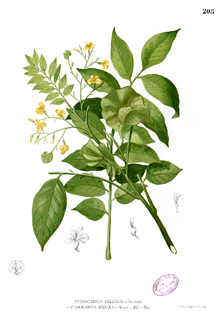Angsana
| Pterocarpus indicus | |
|---|---|
 |
|
| Scientific classification | |
| Kingdom: | Plantae |
| (unranked): | Angiosperms |
| (unranked): | Eudicots |
| (unranked): | Rosids |
| Order: | Fabales |
| Family: | Fabaceae |
| Subfamily: | Faboideae |
| Tribe: | Dalbergieae |
| Genus: | Pterocarpus |
| Species: | P. indicus |
| Binomial name | |
|
Pterocarpus indicus Willd. |
|
| Synonyms | |
|
List
|
|
Pterocarpus indicus (amboine, Pashu padauk, Malay paduak, New Guinea rosewood, Philippine mahogany or, ambiguously, "narra" which can refer to several Pterocarpus species) is a species of Pterocarpus native to southeastern Asia, northern Australasia, and the western Pacific Ocean islands, in Cambodia, southernmost China, East Timor, Indonesia, Malaysia,Papua New Guinea, the Philippines, the Ryukyu Islands, the Solomon Islands, Thailand, and Vietnam. Other names include Narra (Philippines), Sonokembang (Indonesia), Angsana or Sena (Indonesia, Malaysia and Singapore), Tnug (Cambodia).
Pterocarpus indicus was one of the two species (the other being Eysenhardtia polystacha) used as a source for the 16th to 18th-century traditional diuretic known as lignum nephriticum.
Many populations of Pterocarpus indicus are seriously threatened. It is extinct in Vietnam and possibly in Sri Lanka and the Peninsular Malaysia.
It is the national tree of the Philippines.
It is a large deciduous tree growing to 30–40 m tall, with a trunk up to 2 m diameter. The leaves are 12–22 cm long, pinnate, with 5–11 leaflets, the girth is 12–34 m wide. The flowers are produced in panicles 6–13 cm long containing a few to numerous flowers; flowering is from February to May in the Philippines, Borneo and the Malay peninsula. They are slightly fragrant and have yellow or orange-yellow petals. The fruit is a semiorbicular pod 2–3 cm diameter, surrounded by a flat 4–6 cm diameter membranaceous wing (wing-like structure) which aids dispersal by the wind. It contains one or two seeds, and does not split open at maturity; it ripens within 4–6 years, and becomes purple when dry. The central part of the pod can be smooth (f. indica), bristly (f. echinatus (Pers.) Rojo) or intermediate.
...
Wikipedia

